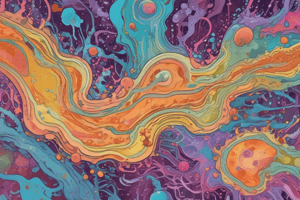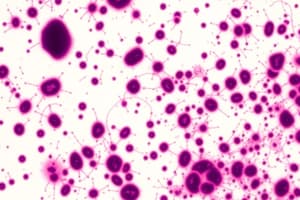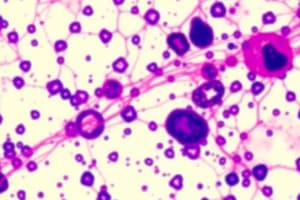Podcast
Questions and Answers
Differential staining is used to differentiate between different types of bacteria based on what?
Differential staining is used to differentiate between different types of bacteria based on what?
- The presence of flagella
- The color of the bacteria
- Certain cellular structures (correct)
- The ability to produce spores
What color do Gram-positive bacteria appear after Gram staining?
What color do Gram-positive bacteria appear after Gram staining?
- Blue
- Violet (correct)
- Pink
- Colorless
What is a key component of the cell wall of acid-fast bacteria?
What is a key component of the cell wall of acid-fast bacteria?
- Peptidoglycan
- Lipopolysaccharide
- Chitin
- Mycolic acid (correct)
What color do acid-fast bacteria appear after acid-fast staining?
What color do acid-fast bacteria appear after acid-fast staining?
What is the primary stain used in acid-fast staining?
What is the primary stain used in acid-fast staining?
What is the role of heat (steam) in acid-fast staining?
What is the role of heat (steam) in acid-fast staining?
What decolorizing agent is used in the acid-fast staining procedure?
What decolorizing agent is used in the acid-fast staining procedure?
What counterstain is used in the acid-fast staining procedure?
What counterstain is used in the acid-fast staining procedure?
What is the purpose of cooling the smear before decolorization in the acid-fast staining procedure?
What is the purpose of cooling the smear before decolorization in the acid-fast staining procedure?
What happens if the cooling step is omitted during acid-fast staining?
What happens if the cooling step is omitted during acid-fast staining?
What is the primary purpose of endospore staining?
What is the primary purpose of endospore staining?
Endospores are formed in response to what type of conditions?
Endospores are formed in response to what type of conditions?
What is the function of endospores?
What is the function of endospores?
What is the primary stain used in endospore staining?
What is the primary stain used in endospore staining?
What is the purpose of steaming in endospore staining?
What is the purpose of steaming in endospore staining?
What counterstain is commonly used in endospore staining?
What counterstain is commonly used in endospore staining?
What color do endospores appear after endospore staining?
What color do endospores appear after endospore staining?
What color do vegetative cells appear after endospore staining?
What color do vegetative cells appear after endospore staining?
What is used as a decolorizing agent during endospore staining?
What is used as a decolorizing agent during endospore staining?
What is the main purpose of capsule staining?
What is the main purpose of capsule staining?
What is a capsule?
What is a capsule?
What is a slime layer?
What is a slime layer?
What is the main component of capsules in bacteria?
What is the main component of capsules in bacteria?
What is one of the main functions of a bacterial capsule?
What is one of the main functions of a bacterial capsule?
How is the slimy layer different from the capsule?
How is the slimy layer different from the capsule?
What is the charge of the capsule and slimy layer, which affects staining?
What is the charge of the capsule and slimy layer, which affects staining?
Which type of staining is used to stain the background in capsule staining?
Which type of staining is used to stain the background in capsule staining?
Why should heat not be used during capsule staining?
Why should heat not be used during capsule staining?
What is used to wash the slide in capsule staining?
What is used to wash the slide in capsule staining?
If you want to stain a slimy layer, where should the bacteria come from?
If you want to stain a slimy layer, where should the bacteria come from?
Flashcards
Differential Staining
Differential Staining
A staining technique used to differentiate bacteria based on cellular structures, mainly the cell wall.
Acid-Fast Staining Technique
Acid-Fast Staining Technique
A special staining technique used to stain Acid-Fast bacteria, which are not stained by other staining techniques.
Carbolfuchsin
Carbolfuchsin
The primary stain used in Acid-Fast staining procedure.
3% Acid-Alcohol
3% Acid-Alcohol
Signup and view all the flashcards
Methylene Blue
Methylene Blue
Signup and view all the flashcards
Spores
Spores
Signup and view all the flashcards
Endospore Staining technique
Endospore Staining technique
Signup and view all the flashcards
Malachite green
Malachite green
Signup and view all the flashcards
Safranin
Safranin
Signup and view all the flashcards
Capsule
Capsule
Signup and view all the flashcards
Slime Layer
Slime Layer
Signup and view all the flashcards
Functions of capsule
Functions of capsule
Signup and view all the flashcards
Slimy layer functions
Slimy layer functions
Signup and view all the flashcards
Indirect simple staining
Indirect simple staining
Signup and view all the flashcards
Direct simple staining
Direct simple staining
Signup and view all the flashcards
Study Notes
Differential Staining
- A staining technique used to differentiate bacteria based on cellular structures, mainly the cell wall.
Gram Staining
- Used to differentiate between Gram-positive and Gram-negative bacteria.
- Gram-positive appear violet.
- Gram-negative appear pink.
- Acid-fast bacteria cannot be stained and appear colorless.
Acid-Fast Staining
- A special technique used to stain acid-fast bacteria.
- Uses steam (heat).
- Acid-fast bacteria contain a waxy-lipoidal material (mycolic acid) in their cell walls.
- Mycolic acid is stain-proof.
- Acid-fast bacteria appear in pink color.
- Nonacid-fast bacteria appear in blue color.
Acid-Fast Staining Technique
- Uses a stain with a chemical nature that interacts with the waxy layer of acid-fast bacteria.
- A lipid-soluble stain containing phenol, such as carbol-fuchsin, can be used.
- Using heat (steam) assists the penetration of the stain through the cell wall by softening the wax.
Acid-Fast Staining Procedure
- Prepare a smear containing a mixture of Bacillus (non-acid-fast) and Mycobacterium (acid-fast).
- Load the slide with carbolfuchsin and steam for 5 minutes.
- Discard excess stain and cool the slide at room temperature for at least 5 minutes.
- Wash gently with a decolorizing agent (3% acid-alcohol).
- Immediately and gently wash with tap water.
- Load the slide with methylene blue and leave to stand for 2 minutes.
- Wash gently with tap water.
- Blot dry with filter paper.
- Acid-fast bacteria appear pink, while non-acid-fast bacteria appear blue.
3% Acid Alcohol
- A mixture of 3 units of acid and 97 units of ethanol (absolute or 95%).
- Functions as the best decolorizer to remove carbol-fuchsin as it is strong enough to dissolve the stain.
- The affinity of carbol-fuchsin to the wax is higher, acid-fast bacterial cells retain the stain, while non-acid-fast cells do not.
Smear Cooling
- A smear must be cooled to allow the wax to harden before decolorization.
- Decolorizing without proper cooling will cause the stain to leave the Mycobacteria and appear colorless since methylene blue cannot enter these cells.
Omitting Coating Step
- If the cooling step is omitted, the mycolic acid will remain in the soft state, and the decolorizer will remove the carbol fuchsin from the Acid-Fast bacteria.
- It will cause the mycolic acid to convert into the hard state resulting in colorless Acid-Fast bacteria and blue Non Acid-Fast bacteria
Endospores
- Highly resistant, dormant structures with no metabolic activity formed in response to adverse environmental conditions.
- Help organisms survive.
- Do not have a role in reproduction.
- Contain a copy of the bacterial genetic material.
Bacterial Genera
- Some genera can exist as metabolically active vegetative cells or as highly resistant, metabolically inactive spores.
- When environmental conditions become unfavorable, vegetative cells undergo sporogenesis and produce endospores surrounded by spore coats.
- As conditions worsen, the endospore is released becoming a free spore.
- Spores are resistant to harsh conditions like heat, freezing, radiation, desiccation, and chemical agents.
- With favorable conditions, free spores revert to vegetative cells through germination.
Classification of Bacteria
- Bacteria can be classified as Spore-Formers or Non-Spore-Formers.
- Spore-Formers are classified as Exospore-Formers (Streptomyces) or Endospore-Formers (Bacillus).
- Endospore-Formers can be classified based on position of spore (terminal, subterminal/subcentral, central) and shape of sporangium (with or without swelling).
Endospore Staining Technique
- Used to check the presence and position of the spore.
- This is important to identify clinically important bacteria.
Endospore Staining Procedure
- Prepare a smear of Bacillus with gentle, even spreading and without heat-fixing.
- Load primary stain consisting of malachite green, steam for less than 5 seconds.
- Cool at room temperature for at least 5 minutes.
- Decolorize by gently washing the slide with tap water.
- Load the counterstain (Safranin) and leave to stand for 1 minute.
- Wash gently with tap water to remove excess stain.
- Blot dry and use microscopy to observe pink vegetative cells with green endospores.
Endospore Staining Effects
- Gently prepared smear prevents release of endospores from vegetative cells.
- Malachite green stains both cells with green color
- Steaming opens pores in the spore coat because it is impervious
- Cooling closes these pores again
- Tap water removes the green primary stain from vegetative cells, making them colorless.
- Safranin stains vegetative cells with pink color.
Endospore Staining Key Points
- The steaming step is most critical because too much heat exposure will release the endospore.
- Tap water is used as a decolorizing agent because both are polar and "like dissolves like."
- Omission of the cooling step will cause both the bacteria and endospore to wash away the tap water.
- The tap water would also act as a coolant, and close pores of the spores, and the result will be a colorless endospore and a pink bacteria
Capsule Layer
- There are several types of bacteria that can produce certain polysaccharides and release them just outside the bacterial cell wall to form an outer layer that covers the outer part of the wall.
- There are several types of bacteria that can produce certain polysaccharides and release them just outside the bacterial cell wall to form an outer layer (cover the outer part of the wall).
- A distinct, regular, tightly attached glycocalyx is called a capsule; an irregular, diffuse layer is a slime layer.
- Cells with a heavy capsule are virulent and disease-producing.
Capsules
- Polysaccharide film extending beyond the cell envelope.
- Well-organized and tightly bound to the cell wall.
- Difficult to remove and can cause diseases.
- Made of polysaccharides; some organisms use other materials, like poly-D-glutamic acid (e.g., Bacillus anthracis).
- Standard stains cannot penetrate because they are so tightly packed and uncharged, making them difficult to stain.
Capsule Functions
- Increases capacity to cause disease (a virulence factor).
- Protects cells from phagocytosis.
- Traps water, prevents bacteria from drying out.
- Protects cells from bacterial viruses and most hydrophobic toxic products like detergents.
- Aids in adhesion of cells to surfaces.
Slimy Layer
- Easily removable, unorganized layer of extracellular material surrounding bacteria.
- Composed mostly of glycoproteins, glycolipids, and exopolysaccharides.
Slimy Layer Functions
- Protects from environmental dangers like antibiotics and desiccation.
- Facilitates adherence to smooth surfaces like prosthetic implants.
- Functions as food storage to survive.
- Prevents unnecessary drying due to environmental factors like temperature and humidity.
- Survives chemical sterilization.
- A protective response to attacks from the immune system.
Capsule Staining Considerations
- Staining depends on attraction and repulsion between the charge of bacterial cells/structures and that of the stain.
- Since Capsules and slimy layers are uncharged both:
- Indirect simple staining: Stains the background using Nigrosine, India ink, or Pelikan 4001.
- Direct simple staining: Stains bacterial cells using any basic dye.
- The unstained area between stained cells and the stained background is the capsule.
Capsule and Slimy Layer Considerations
- The capsule and slimy layer dissolve in water and by heat.
- Avoid use in capsule preparation.
- Use 40% CUSO4 to wash excess stain, make a waxy layer over the smear to fix it, and prevent washed-out or shiny appearance.
- To stain the slimy layer, collect the necessary bacteria directly from the original sample, as the slimy layer is loosely attached.
Studying That Suits You
Use AI to generate personalized quizzes and flashcards to suit your learning preferences.




